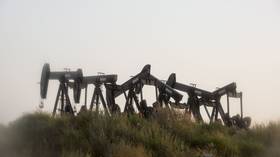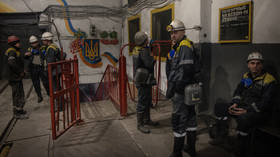Wall Street loses faith in shale

To Wall Street, the shale industry has lost a lot of its allure. A decade’s worth of promises have failed to materialize, and Big Finance is cutting some of its ties with smaller shale drillers who have not delivered.
The Wall Street Journal reports that the shale industry only saw $22 billion in new bond and equity deals, down by more than half from 2016 levels, which was a much worse time for the market.
The steep decline in new debt and equity issuance is a sign that major investors are no longer rushing to finance unprofitable shale drilling. It’s worth noting that this is a new development. For years Wall Street financed unprofitable drilling, holding out on the promise that rapid production growth would eventually pay off.
Also on rt.com China reveals massive oil & gas discovery in Bohai SeaShale wells suffer from precipitous decline rates, with as much as three quarters of a well’s total lifetime production coming out in the first year or two. After an initial burst of output, shale wells enter a steep decline.
Of course, this has been known since the beginning and Wall Street has long been fully aware. But major investors hoped that shale companies would scale up, achieve efficiencies and lower breakeven prices to the point that they could turn a profit.
However, that has not been the case. While there are some drillers that are profitable, taken as a whole the industry has been cash flow negative essentially since its beginning in the mid-2000s. For instance, the IEA estimates that the shale industry posted cumulative negative free cash flow of over $200 billion between 2010 and 2014.
Read more on Oilprice.com: China’s supergrid faces one major problem
The red ink has narrowed since then, but so too has the patience from Wall Street. In 2018, even as oil prices hit their highest levels in years, new debt and equity issuance plunged. That makes it harder for small and even medium-sized companies to finance growth. It’s not all that surprising, then, that a wave of spending cuts have cropped up in the last few months.
The WSJ notes that the credit environment also worsened when the market hit its nadir in 2016. Regulators tightened lending requirements, raising the cost of capital for indebted drillers. That, of course, made it even more difficult for these drillers to turn a profit.
To top it off, all of these pesky investors are much more demanding than they used to be, calling on companies to stop spending so much and instead return cash to shareholders. That leaves less capital available to inject back into the ground. Earlier this month Barclays issued a double-downgrade to Occidental Petroleum, lowering it from Overweight to Underweight, citing the company’s deficit after dividends at a time when the driller still expected to aim for an aggressive production target.
Also on rt.com Nigeria seeks $20 billion in back taxes from oil majorsBut some companies are between a rock and a hard place. The WSJ notes that CNX Resources has lost over 20 percent since late January when it announced that it was bowing to investor pressure to cut spending. That led to speculation that the company wouldn’t meet its production target. It’s a no-win situation for some.
What to make of all of this? As Liam Denning of Bloomberg Opinion put it, “the prevailing financial model for many frackers has hit a wall.” Denning points out that the shale industry has not posted a return on capital above 10 percent any year since 2006, which says is a “feature of shale, not a bug.”
According to Rystad Energy, the 33 largest publicly-traded shale companies, accounting for 39 percent of US shale output, will struggle to please shareholders while also trimming debt. “Shale E&Ps struggle to please equity investors and reduce leverage ratios simultaneously. Despite a significant deleverage last year, estimated 2019 free cash flow barely covers operator obligations, putting E&Ps on thin ice as future dividend payments remain in question,” Rystad Energy senior analyst Alisa Lukash said in a statement.
Read more on Oilprice.com: European oil demand is shockingly weak
Taking a step back, explosive shale growth was only possible because in the context of the post-2008 financial crisis and the response by the Federal Reserve to drop interest rates close to zero, something Bethany McLean argues in her book, “Saudi America.” Cheap money financed the debt-fueled shale revolution.
Rystad finds that over half of the total debt pile for the 33 companies it analyzed is due within the next seven years. Ultimately, the industry may have to erase $4 billion in promised dividend payments. “The obvious gap in expected versus likely dividend payments confirms the industry’s inability to deliver sustained investors’ payback while simultaneously deleveraging,” Lukash said.
Also on rt.com US imports of ‘sanctioned’ Venezuelan oil surge fivefoldThat doesn’t mean that production is going to fall off of a cliff. These days, the shale drilling frenzy is being pushed along increasingly by the oil majors, who have gobbled up smaller companies. ExxonMobil and Chevron, for instance, can take a long view, and put mountains of cash into drilling. Investor pressure is different for these multinationals and, in any event, they are much more profitable than smaller shale companies due to various assets in refining, chemicals, offshore and otherwise conventional production.
As such, production growth will continue for a while longer. But the go-go days are over.
This article was originally published on Oilprice.com















